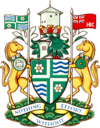Langley, British Columbia (district municipality)
| Langley | |||
|---|---|---|---|
| District municipality | |||
| The Corporation of the Township of Langley | |||

Township of Langley City Hall
|
|||
|
|||
| Motto: "Nothing Without Effort" | |||
 Location of Langley Township in Metro Vancouver |
|||
| Country |
|
||
| Province | British Columbia | ||
| Regional District | Metro Vancouver | ||
| Incorporated | April 26, 1873 | ||
| Government | |||
| • Mayor | Jack Froese | ||
| • Councillors |
List of Councillors
|
||
| • MP |
John Aldag (LPC) Mark Warawa (CPC) |
||
| • MLA | Mary Polak (LIB) Rich Coleman (LIB) |
||
| Area | |||
| • Land | 308.03 km2 (118.93 sq mi) | ||
| Population (2011) | |||
| • Total | 104,177 | ||
| Time zone | PST (UTC-8) | ||
| • Summer (DST) | PDT (UTC-7) | ||
| Highways |
|
||
| Website | Township of Langley | ||
The Township of Langley is a district municipality immediately east of the City of Surrey in southwestern British Columbia, Canada. It extends south from the Fraser River to the U.S. border, and west of the City of Abbotsford. Langley Township is not to be confused with the City of Langley, which is adjacent to the township but politically is a separate entity. Langley is located in the eastern part of Metro Vancouver.
Throughout the last several millennia, the area that is now Langley Township was inhabited by various Stó:lo nations, including the Katzie and Kwantlen. There is limited recorded history from this time, as much was passed down through oral tradition rather than written documents. The Kwantlen were a major factor in the salmon trade that later operated out of the Fort Langley. Simon Fraser, while traveling through the Sto:lo territory in 1808 recorded the image of a Kwantlen village:
The first Europeans to stay in the area permanently were the traders of the Hudson's Bay Company (HBC). In 1827, Fort Langley was built on the banks of the Fraser River, in the area now known as Derby Reach. It was one of a string of trading posts built up and down the Pacific Coast to compete with American fur traders for the rich pelts available in the region. Farming as well as cranberry and salmon exports soon replaced fur trading as the fort's primary source of income.
The first fort (1827-1839), built with two bastions, a wooden stockade and several buildings, proved to have been built too close to a fast-moving part of the river, in an area prone to flooding. It was rebuilt in 1839 farther upstream. As the HBC's network of forts in the interior grew, Fort Langley became a hub for farming, smithing and for shipping furs back to Europe. Along with farming, the export of cranberries and salmon would soon become the fort's main source of profit.
...
Wikipedia


